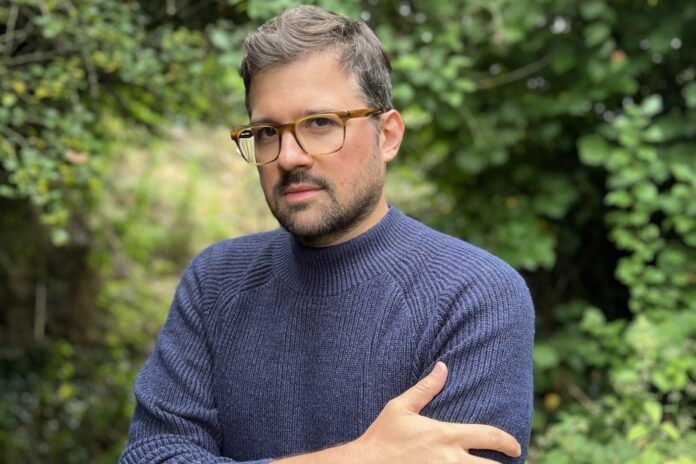Audacity and patience paid off for Martin Panchaud: The Color of Things, his first book in the style that we would like to call “IKEA comics”, won him nothing less than the Fauve d’or of the best album of the year at the last Angoulême Festival. The Swiss cartoonist is one of the guests of the Montreal Comics Festival, which begins on Friday rue Saint-Denis.
He didn’t come to comics by drawing. He candidly admits to not being very familiar with the classics of the 9th art. He developed his way by adapting one of the films of the Star Wars series, but explains it by referring to Saint-Exupéry’s The Little Prince. Martin Panchaud is no ordinary cartoonist. His first book, to be placed in the department of fantastically original romantic comics, is not an ordinary book either.
As its title does not indicate, The Color of Things tells the story of Simon, a chubby 14-year-old Englishman who lives in a not very functional family and is bullied by little bums in his neighborhood. His life will change the day when, on the advice of a fortune teller, he plays the races and wins a fortune.
Will money make her happy? Not always. In any case, not immediately, we see by following him between London, Birmingham and Liverpool in his quest to find his father and save his mother.
Telling the story first is the trick used by a bookseller to arouse the interest of readers, says Martin Panchaud during an interview conducted shortly before his arrival in Quebec, where he is one of the guests of the Montreal BD Festival, held from Friday to Sunday on rue Saint-Denis, between Roy and Gilford. “He thought it was the best way to make readers not think it was going to be a boring book, a hard read,” says the cartoonist, without irony.
The artist, who studied graphic design, opted for a style that has no desire to give the illusion of reality: the action is always seen from above, without any perspective, its visual language borrows from technical, advertising and illustration quotes, and its characters are simple circles of color that move in sets with just enough recognizable elements to situate the reader.
Abstract, all that? Much less than such a description might lead one to believe. Martin Panchaud has actually worked hard to achieve an evocative minimalism. “The idea was to tell a story with as few elements as possible,” he explains. I found that to talk about geometric shapes, it works. The brain does the translation and thinks, this round shape is a human. Then I had to guide the reading by giving the reader things he recognized. »
This game with the reader – it is indeed more playful than cerebral -, he connects it to the sheep that the aviator of Saint-Exupéry is unable to draw for his Little Prince and that he ends up putting in a box: l he annoying blond has only to imagine it to be satisfied. Martin Panchaud also applied this approach in an adaptation of the fourth installment of the Star Wars series, A New Hope, which unfolds like a medieval tapestry and can still be read on the internet.
From the author’s point of view, it’s a way of inviting the reader to “fill in the gaps” he leaves visually. “I like to think that the more a reader is involved in deciphering a universe or a story, the closer it brings them to [characters’] emotions and actions,” he says.
The American master of the strange indeed uses such vague language that he only evokes places and atmospheres, forcing his readers to project their own fears and discomforts onto it.
There is a distant relationship between Martin Panchaud and Chris Ware, whose style also has something technical and straight. The Swiss cartoonist, however, builds his boards in a much more refined way than the American and skilfully uses all the tools at his disposal, from typography to the IKEA plan, from the logo to the technical drawing, to enrich his story and make something of it. amazing. Hence this Fauve d’or, which crowns a singular approach and a work that will appeal to readers more eager to explore new territories than to dive into a thousandth version of Thorgal.
There are several paths to get to the heart of the reader. Boum (The jellyfish), Jean-Louis Tripp (The little brother) and Martin Panchaud (The color of things) will all come to exhibit the tools they favor to make their pages touching. The discussion will take place on Saturday, at stand E36, rue Saint-Denis, near rue De Bienville.
The MU team will teach the basics of comics to young people, who will be able to leave with their creations, of course. The workshop is offered from Friday to Sunday at 3:00 p.m. and 3:30 p.m., at the corner of Saint-Denis and Gilford streets, where artists Dominique Desbiens and Bruno Rouyère will create a mural on behalf of MU in tribute to Michel Rabagliati . The creator of the Paul series made the model himself.
Artist and researcher Simon Demeule and cartoonist Jean-Paul Eid (Le petit astronaute, Memoria, La femme aux cartes postales) will discuss the effects of artificial intelligence (AI) on the graphic arts. Is this just one more tool for creators? Meet at stand E37, rue Saint-Denis near rue De Bienville, Sunday at 2 p.m.















